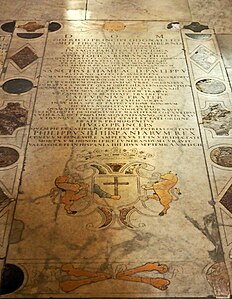Escape of the counts

Flight of the Earls (" Flight of the Earls ", Irish Imeacht na nIarlaí or Teitheadh na nIarlaí ) refers to a historical event in Ireland in 1607, in which the Earls Hugh O'Neill (2nd Earl of Tyrone ) and Rory O'Donnell (1st Earl of Tyrconnell ) left the Irish island with some of their relatives to avoid the threat of imprisonment.
history
The critical point of the Elizabethan conquest of Ireland was when the British tried to extend their power to the area of Ulster and the clan of Hugh O'Neill (the most powerful lord in Ireland at the time). O'Neill defended himself with armed force and thus unleashed the Nine Years War (1594 to 1603), which hit the whole island and had the aim of completely driving the English off the Irish island. O'Neill succeeded in setting up an army consisting of about 10,000 Irish. An English army sent to combat O'Neill's troops was surprisingly attacked by them near Clontibert and defeated. Three years later, on August 14, 1598, the battle of the Yellow Ford broke out , which also ended in a severe English defeat.
Queen Elizabeth I installed Lord Mountjoy as the new Lord Deputy in Ireland in 1600 . In the north of Ireland, he was responsible for the destruction of the harvest and had the herds of cattle confiscated there in order to deprive the rebels of their basic food sources. Mountjoy's further advance into Ulster, however, was stopped by O'Neill and his troops on October 2-3, 1600 at the Battle of Moyry Pass . O'Neill received support from 3,500 Spanish soldiers who were killed by King Philip III. and went ashore at Kinsale on September 21, 1601 . English troops under Mountjoy began the siege of the city a little later. At the end of December, O'Neill and his army arrived at Kinsale to end the siege by force (→ Siege of Kinsale ). The attempt failed and the Spanish garrison capitulated. After some more fighting, O'Neill and O'Donnell negotiated a truce with the English in 1603 so that both could eventually retain their original lands and titles.
But in 1605 the new Lord Deputy of Ireland, Arthur Chichester, 1st Baron Chichester , began to restrict the freedoms of the two earls. Both feared imprisonment, and now that Ireland was completely under English control again, both decided to leave the Irish island for the European continent.
In September 1607 O'Neill and O'Donnell sailed with 90 of their relatives and subordinates from Rathmullan (a place on Lough Swilly in County Donegal ) towards Spain . But they already went ashore in France and finally reached Italy by land . After their death they were buried in the church of San Pietro in Montorio in Rome. Her tombs are in the floor of the nave of the church:
The "Flight of the Earls" marks the final resolution of the historic Gaelic aristocracy and paved the way to the Plantations of Ulster .
memory
In the “Flight of the Earls Center” in the Martello Tower in Rathmullan, an exhibition commemorates this historical event.
literature
in order of appearance
- Tadhg O Cianáin: The Flight of the earls , translated and edited by Paul Walsh (title of the Irish manuscript: Turas na dTaoiseach nUltach as Éirinn ). Gill, Dublin 1916.
- John McCavitt: The flight of the earls . Gill & Macmillan, Dublin 2002, ISBN 0-7171-3047-9 .
- David Finnegan, Éamonn Ó Ciardha, Marie-Claire Peters (eds.): The flight of the Earls / Imeacht na nIarlaí . Guildhall Press, Derry 2010, ISBN 978-1-906271-32-9 (Irish and English).
- Aubrey Flegg: Fugitives! A story of the flight of the Earls . O'Brien, Dublin 2010, ISBN 978-1-84717-202-0 (historical novel).
Footnotes
- ^ Gerard Hayes-McCoy: Tudor conquest (1534-1603) . In: Theodore W. Moody, Francis Xavier Martin (eds.): The course of Irish history . Mercier Press, Cork, 17th ed. 1987, ISBN 0-85342-715-1 , pp. 174-188, here pp. 184-187.
- ^ Gerard Hayes-McCoy: Tudor conquest (1534-1603) . In: Theodore W. Moody, Francis Xavier Martin (eds.): The course of Irish history . Mercier Press, Cork, 17th ed. 1987, pp. 174-188, here p. 188.
- ↑ Aidan Clarke: Colonization of Ulster and the rebellion of 1641 . In: Theodore W. Moody, Francis Xavier Martin (eds.): The course of Irish history . Mercier Press, Cork, 17th ed. 1987, pp. 189-203, here pp. 189-190.

